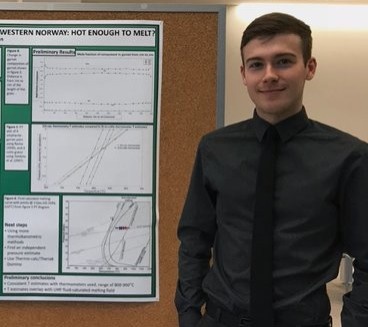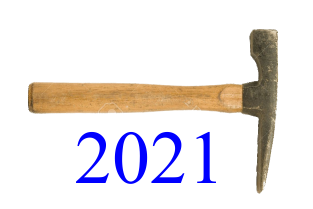Benjamin Myrer

B. Sc. Honours Thesis
Thermobarometry of Eclogite from the Nordøyane Ultra-High Pressure Domain, Western Gneiss Region, Norway
(PDF - 4.0 Mb)
Powerpoint Presentation (PDF)
Partial melting of subducted continental crust at ultra-high pressure (UHP) conditions may facilitate the exhumation of large UHP terranes like the Western Gneiss Region (WGR), Norway. During the Scandian phase of the Caledonian orogeny, the subduction of Baltica beneath Laurentia resulted in eclogite-facies metamorphism of the WGR from ca. 415-405 Ma. In the Nordøyane UHP domain, the hottest domain in the region, eclogite bodies hosted in migmatitc orthogneisses well exposed sections of Kvernholmen and Flemsøya. Direct evidence for UHP metamorphism includes the discovery of coesite-bearing eclogite from northern Flemsøya and from Harøya. While there is abundant evidence for melting of the host rocks during decompression, evidence that partial melting occurred at peak pressure and temperature (P-T) conditions has not yet been observed. By examining eclogites from the domain that appear least affected by retrogression, this study is designed to test the hypothesis that the peak P-T conditions recorded in the eclogite bodies overlap with the field where UHP melting is possible for the host rocks. The eclogite-facies mineral assemblage comprises omphacite + garnet + biotite + orthopyroxene ± rutile ± zircon, locally overprinted by retrograde amphibole + plagioclase ± biotite ± orthopyroxene ± clinopyroxene2, with symplectite present along omphacite-garnet grain boundaries. Inclusions of quartz are rare in garnet and coesite is absent in the studied samples. Garnet hosts inclusions of omphacite, rutile, zircon, apatite, orthopyroxene, and idioblastic biotite. Fe-Mg exchange thermometry applied to garnet-clinopyroxene, garnet-biotite, and garnet-orthopyroxene pairs yielded a T range of ca. 800-950 °C at 30 kb, assuming Fe2+ = Fetotal, and 500-750 °C if Fe3+ is calculated stoichiometrically. The discrepancy in T estimates when using Fe2+ or Fe3+ is interpreted as an affect of retrograde diffusion, resulting in unreliable T results. The Zr-in-rutile thermometer yielded T of ca. 700-820 °C at 20 kb, and ca. 750-860 °C at 30 kb, and because rutile is less susceptible to retrograde diffusion, these temperatures are interpreted as reliable. Thermodynamic modelling done with bulk composition CB15-19, paired with the Zr-in-rutile thermometer, yielded the best P-T range for CB15-19 of ca. 800-820 °C and ca. 25-32 kb. The inferred P-T conditions overlap with the fluid-present melting range for UHP rocks, however, there is no evidence for fluid infiltration or in situ melting of the eclogite bodies at peak P-T conditions. It therefore seems unlikely that partial melting of the host rocks at peak UHP conditions facilitated the exhumation of the subducted WGR crust in the Nordøyane domain.
Key words: Western Gneiss Region, Nordøyane domain, ultra-high pressure metamorphism, eclogite-facies metamorphism, thermobarometry, thermodynamic modelling
Pages: 84
Supervisor: Rebecca A. Jamieson



